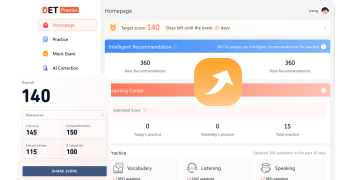デュオリンゴ英語テストの「写真について書く」セクションをマスターする
デュオリンゴ英語検定は、英語能力を証明したい非ネイティブスピーカーにとって重要な基準となっています。オンラインで簡便にアクセスでき、結果も迅速に得られるため、英語圏の環境での進学や就職を目指す学生や専門家の間で人気があります。このテストのユニークで挑戦的な部分の一つが「Write About the Photo」セクションで、受験者の流暢さとその場での思考力、観察を簡潔かつ明確に伝える能力が測られます。
このセクションでは、日常生活の何気ない瞬間を捉えた写真が提示されます。一見通り過ぎてしまうような場面でも、テストの視点から見ると、何気ない瞬間が言葉で描かなければならないキャンバスとなります。わずか1分間で、写真の詳細を説明する能力が大学や就職の機会を開くスコアに繋がることもあります。
この投稿では、このセクションをマスターするための戦略に深く掘り下げ、あなたの記述が際立つようにする方法をお伝えします。画像の本質を捉え、言語能力を反映する鮮やかで生動感のある記述を書くための重要なヒントをカバーします。熟練した英語話者であろうと、英語力を磨いている途中であろうと、記述の技術をマスターすることがデュオリンゴ英語試験で成功する鍵です。
シンプルな画像を英語の語彙の豊かさと観察力の鋭さをアピールする機会に変える方法を探りながら、是非ご期待ください。
1. 問題の理解
Write About the Photoタスクは、シンプルですが深い意味を持つものです。受験者には写真が提示され、それを1分以内に説明することが求められます。指示はシンプルですが、実行することが課題です。このセクションは、単に見えるものだけでなく、その視覚的な詳細を言語でどのように解釈し伝えるかが重要です。
この問題を真に理解するためには、それが二重の目的を果たしていることを認識する必要があります。まず、視覚刺激に対する即時の反応を評価し、考えを迅速に整理し、一貫性のある説明的な言語に変換する能力をテストします。次に、具体的には語彙の範囲、文構造、スペリングの正確性など、英語の識字能力を評価します。
この問題をマスターする鍵は、速度と内容のバランスを取ることです。説明は、単に写真にある物を特定するだけでは不十分です。このテストは、効果的にコミュニケーションを取る能力を測るため、多様な文構造、豊富な描写的言語、および正確な文法を使用する必要があります。例えば、賑やかな都市の通りを犬と一緒に歩く男性を説明する場合、感覚的な詳細、可能な感情、アクションなど、シーンを生き生きとさせる要素を含めましょう。
この質問を理解するということは、写真に対して深いレベルで関与する準備をすることを意味します。直接的に見えるものだけでなく、その場面が示唆しているものや背景として考えられる要素を描写する準備をしましょう。例えば、人々の表情、天候、設定の雰囲気などが説明に豊かさを加えます。
このセクションの準備において、練習は極めて重要です。様々な写真に親しみ、1分以内にそれらを説明する練習をしてみてください。これにより速度が向上するだけでなく、プレッシャーの中で批判的かつ創造的に考える力が養われます。
以下のセクションでは、記述能力を向上させ、デュオリンゴ英語検定のこの独特で洞察力のある部分で成功するための実践的なヒントと練習方法を提供します。
2. 成功するための記述のヒント
デュオリンゴ英語検定の「Write About the Photo」タスクで成功するためのいくつかの重要な戦略があります。効率的かつ効果的な記述を作成するために以下の方法で準備しましょう:
- 観察力を鍛える: 試験前に様々な写真を観察し、見える詳細を書き留めましょう。写真の本質を鮮やかな言葉で描く練習をしてください。
- 描写語彙を増やす: 記述の豊かさは、使用できる単語の多様性に大きく依存します。色、形、感情、動作を正確に伝える形容詞や動詞を学びましょう。
- 記述の構造を考える: 時間に制約がある中でも、頭の中でアウトラインを持つことが役立ちます。シーンについての一般的な声明から始め、具体的な詳細に移り、興味深い観察やコメントで締めくくります。
- 感覚を引き込む: 見えるものだけに焦点を当てるのではなく、潜在的な音、匂い、雰囲気を取り入れて、マルチセンソリーな記述を作成しましょう。
- 高速タイピングの練習: タイムドタイピングの練習をして、迅速に考え入力することに慣れましょう。タイマーを使って試験条件をシミュレートし、改善点をレビューしてください。www.typing.com や www.keybr.com のようなウェブサイトを使ってタイピングスキルを練習できます。
- 一般的な欠点を避ける: 写真の項目のリストや一般的な声明を避けましょう。代わりに、要素を結びつけるナラティブやテーマに基づく声明に焦点を当てましょう。
- 比較表現や比喩を使用する: 比喩やメタファーを使うことで、記述に深みを加え、高度な言語スキルを披露できます。例えば、「The sky is blue」と言う代わりに、「The sky is as blue as a robin’s egg」と言うことができます。
- 文法と句読点の見直し: 誤りは記述の質を損ないます。基本的な文法や句読点の規則に慣れ、単純なミスを避けましょう。
- 評価基準を理解する: 応答がどのように評価されるかを理解しましょう。AI評価者が何を求めているかを知ることで、練習や実際の試験応答をそれに合わせて調整できます。
- フィードバックを活用する: 可能であれば、練習記述に対するフィードバックを教師やネイティブスピーカーからもらいましょう。その洞察を活かしてアプローチを洗練させます。
これらのヒントを準備に取り入れることで、「Write About the Photo」セクションに自信を持って臨むことができます。目標は、見たものを単に説明するだけでなく、分析し、明確かつ創造的に考えを表現する能力を示すことです。
3. 読解力と理解力の向上
読み書き能力と理解力は、「Write About the Photo」タスクにおける効果的なコミュニケーションの基盤です。これらのスキルを向上させる方法をご紹介します:
- 広く頻繁に読む: 小説、新聞、雑誌、オンライン記事など、様々な読み物に触れてください。これにより、様々な文体に触れ、語彙が増え、テストの際に多くの単語や表現を引き出せるようになります。
- 能動的な読書を実践する: 読んでいる間に興味深いフレーズや珍しい単語、その文脈をメモしましょう。新しい単語の意味を周囲のテキストから推測し、その後調べることで、推論力を高めることができます。
- 視覚メディアに触れる: 読書だけでなく、ドキュメンタリー映画や写真キャプション付きの映画など、視覚メディアにも触れてください。視覚要素がどのように言葉で説明されているかを分析することで、効果的な描写技術の洞察が得られます。
- フラッシュカードを使う: 新しい語彙を定義、同義語、および例文とともにフラッシュカードにまとめましょう。これらのフラッシュカードを定期的に復習することで、試験条件下での単語の想起を容易にします。
- 要約を書く: 記事を読んだりビデオを見た後に要約を書く練習をしましょう。この練習により、写真を見てハイライトするポイントを決定する際に重要な地点やテーマを識別する能力を養うことができます。
- 学んだことを議論する: 読んだ資料について友人や学習グループと議論してください。概念を説明し解釈を議論することで、理解を深め、複雑なアイデアを表現する能力を向上させることができます。
- 建設的なフィードバックを求める: できる限り、書いた作品に対するフィードバックを求めましょう。他の人が自分の記述をどのように解釈するかを理解することで、文章をより明確かつ効果的にする手掛かりになります。
- ライティングワークショップに参加する: 利用可能な場合は、ライティングスキルに焦点を当てたワークショップやオンラインコースに参加しましょう。構造化された学習環境は、貴重な指導と練習の機会を提供します。
- 言語学習アプリを活用する: Duolingo のようなアプリは、楽しくインタラクティブな方法で読解力やライティングスキルを向上させるための練習問題を提供します。多くのアプリは、スキルレベルに応じて適応するように設計されています。
- 描写練習を行う: 周囲の環境や一日の出来事をできるだけ詳細に描写する時間を定期的に設けてください。これにより、明確かつ生き生きとした言葉でイメージを構築する練習ができ、読み書き能力と理解力が向上します。
これらのスキルを向上させることは、時間と献身を要するプロセスです。積極的に読み書き能力と理解力を向上させることで、「Write About the Photo」タスクに取り組む際に、強い英語力を発揮できるようになります。
4. サンプル記述と分析
「Write About the Photo」セクションでは、詳細と場面の雰囲気を捉えた堅実な記述が求められます。提供された画像のサンプル記述を分解し、どのようにこれを達成するか見ていきましょう。

*画像1: フェスティブカナインポートレートのサンプル記述: 「A Pomeranian dog, adorned with a festive Santa hat and a bowtie, exudes holiday cheer as it nestles within a red gift box. The warmth of the wooden background, adorned with Christmas decor, complements the dog’s joyous expression.」
分析:
- 描写言語: 「adorned」、「exudes」、「nestles」などの言葉が記述に洗練されたレベルを加えています。
- 詳細な観察: 犬種や背景の装飾の種類を言及することで、より生き生きとした絵を描いています。
- 雰囲気の伝達: 「holiday cheer」というフレーズが写真のムードを設定し、読者にフェスティブな精神を感じさせます。

*画像2: 海上の軍艦のサンプル記述: 「A formidable naval ship slices through the azure waters, its white hull contrasting sharply against the calm sea. Smoke trails from the ship’s stack, indicating activity aboard this sentinel of the sea.」
分析:
- 動詞の使用: 「slices」や「trails」が動きやアクションの感覚を与えています。
- 色の対比: 「white hull」と「azure waters」の対比が明確な視覚的対照を提供します。
- 比喩的言語: 船を「sentinel」と呼ぶことで、海上の警備役割を示唆する比喩が加わっています。

*画像3: 父と娘の瞬間のサンプル記述: 「A father, with a gentle smile, embraces his two young daughters against a backdrop of white-washed walls.Their matching gray attire and similar features speak to the familial bond they share.」
分析:
- 感情的なつながり: 記述は「gentle smile」や「embrace」に焦点を当て、写真の感情的な側面を強調しています。
- テーマの一貫性: 「matching gray attire」や「similar features」の記述が家族と団結のテーマを強調しています。
- 背景の詳細: 「white-washed walls」を含めることで文脈を提供し、記述を具体的にしています。
これらの記述は、単に目に見えるものだけでなく、画像が伝える暗示的な詳細や感情も考慮しています。観察と解釈を織り交ぜた記述は、写真と深く関わる能力を示しています。このような描写分析を練習することで、デュオリンゴ英語検定だけでなく、英語での全体的なコミュニケーションスキルも向上させることができます。
記述の技術と英語力への影響
各セクションを通じて試し、サンプル記述を分析してきた通り、「Write About the Photo」タスクは単なる観察の演習以上のものです。それは、言葉で人生の瞬間を捉える能力をテストし、あなたの英語スキルを分析的かつ創造的な方法で活用することに挑戦しています。これは、現実のコミュニケーションの複雑さを反映しています。
このタスクで評価される能力は、語彙の広さや文法の正しさだけではなく、単一の画像を通して物語を語る能力でもあります。このスキルは、英語の試験に合格するためだけでなく、英語が表現手段となる環境で成功するためにも非常に価値があります。
英語をマスターする旅の中で、記述の技術を深い理解と流暢さを高めるための入口として活用しましょう。画像に触れ、言葉で遊び、コミュニケーションのニュアンスを受け入れてください。あなたの努力は、試験のスコアに反映されるだけでなく、グローバルな聴衆との接続や会話能力にも反映されます。
「Write About the Photo」セクションの準備をする際には、見えるものだけでなく、感じること、推測すること、想像することについても書くことを忘れないでください。世界は語られるのを待っている物語のモザイクであり、あなたの記述を通じてそれらを生き生きと蘇らせる力を持っています。
こちらをクリックしてさらにDET準備戦略をチェックしてください。
DETについてのヒントを探していますか?ここを参照してください: https://www.detpractice.com/category/pro-test-tips/
今すぐ無料でDET質問バンクに登録して練習を始めましょう。
*免責事項: 著作権フリーのサンプル画像の使用について
このブログ投稿で使用されている画像は、教育的および説明的な目的のために意図された著作権フリーのサンプルです。これらはデュオリンゴ英語検定(DET)からの実際の写真ではなく、DETとは提携しておらず、推薦もされていません。提供される記述は、英語能力試験の文脈で写真について書く方法を示すために作成されたものです。すべての画像と説明は、受験者が遭遇する可能性のある写真のタイプと、彼らの応答に期待される詳細と分析のレベルを準備するのを助けるために使用されています。公式な練習資料とテスト情報については、デュオリンゴ英語検定の公式リソースを参照してください。






